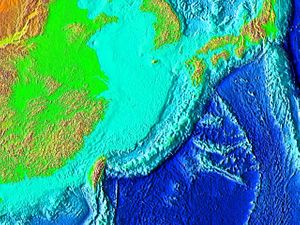Much has been said and written already about China’s unilateral establishment of an Air Defense Identification Zone (ADIZ) earlier this week. Reactions in Japan and the United States have been well-documented, but little analysis has been devoted exclusively to the South Korean angle on the ADIZ issue. The ADIZ, even it was a ham-fisted and poorly conceived strategic attempt to exert Chinese sovereignty over the disputed Diaoyu/Senkaku islands, did not necessarily have to overlap with about 3,000 square kilometers of South Korea’s own ADIZ, encompassing Ieodo (Suyan) Rock and grazing the Western fringe of Jeju-do’s airspace in the process.
Coverage from Monday in the South Korean press was less-than-sympathetic to the Chinese ADIZ. The Hankyoreh began its report by noting the inclusion of Ieodo in the ADIZ. The Chinese press, for its part, immediately disseminated a Chinese defense ministry statement that China had “no territorial dispute” with Seoul over Ieodo in an attempt to offset the tension. The report included a statement by Qin Gang, a Chinese foreign ministry spokesman, who clarified that the two would resolve the issue via “friendly consultations and negotiations.”
The official South Korea response was significantly more muted than Japan’s. For example, Park Geun-hye did not make any public denunciations of the ADIZ while Shinzo Abe responded publicly and comprehensively. The South Korean high-level response came from Kim Min-seok, the defense minister, who said that Korea would continue to fly in the area covered by the ADIZ without informing China. The Wall Street Journal reports that South Korean Foreign Minister Yun Byung-se, speaking at a defense forum, said that the ADIZ imposition by China had made “tricky regional situations even more difficult to deal with” — a fairly muted response.
South Korea will have the first opportunity to engage in a high-level defense dialogue with China over the ADIZ issue tomorrow when the Korea-China vice defense ministerial-level strategic dialogue takes place. The ADIZ was included on the agenda at the last minute, and Chinese delegates are expected to clarify the meaning of the ADIZ to their South Korean counterparts. China officially maintains that the ADIZ is a stabilizing attempt to reduce misunderstandings in the air — something its neighbors and the United States have been reluctant to accept.
However, a Xinhua piece announcing the fact that South Korea and China would discuss the ADIZ at the dialogue beginning tomorrow included the same sort of assertive language used in the general ADIZ announcement: “Any airplane that fails to follow such rules will face emergency defense measures taken by the Chinese military.” This implies that China is not ready to make any exceptions for South Korea.
The beauty of a unilateral move like an ADIZ is that the country imposing the zone gets to decide how the lines are drawn on the map. The Chinese decision to draw the ADIZ such that it was guaranteed to raise the ire of South Korea is odd. With South Korea, the PRC was fortunate enough to avoid the sorts of territorial rigmaroles it often finds itself in with Japan, Taiwan and various Southeast Asian states (over the South China Sea). South Korea and China had also found themselves converging over their common historical distaste for Japan along nationalist lines — a phenomenon abetted by the almost concomitant election of conservative Park Geun-hye in Korea and Shinzo Abe in Japan.
It’s perhaps too early to make a definitive determination about the impact the Chinese ADIZ will have on future relations between China and South Korea. South Korea’s restrained rhetorical response and China’s immediate attempts to set the record straight on Ieodo indicate that the ADIZ’s northeastern frontier, near Jeju-do, may have been an oversight on China’s part.
On the flip side, China, which sees the ADIZ as an important defensive measure, may have made a strategic calculation that running the ADIZ’s frontiers so close to South Korean airspace could offer a greater buffer against United States’ forces based in South Korea. Of course, if yesterday’s B-52 flyby showed the Chinese anything, that may have been somewhat of a miscalculation as well.
What should give South Korea pause over the ADIZ is the possible imposition of such zones in the future by China, something Chinese Ministry of Defense spokesman Yang Yujun claimed was in the pipes: “China will establish other Air Defense Identification Zones at the right moment after necessary preparations are completed.” A future ADIZ off the Bohai Sea and into the Yellow Sea would have serious implications for South Korean security.

































